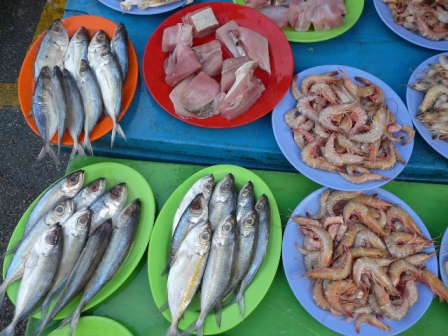
Choose your fish for dinner
Click the photo above to see an album of Borneo photos. Close the window to return to this page.
Read Previous Episode: Weng Longhouse or Next Episode: Gunung Mulu National Park
|
|
| |||||||
|
Dec 15 2008 Part of the fun of visiting a new town is to visit their market. There
are at least one or two markets in each town and they are well attended.
The markets are about equally divided between a "wet" market and a "dry"
market. We prefer the wet market areas, that is, the ones that sell
fresh food, including fruits, vegetables, seafood, chickens and pork.
The vendors sit or a chair or a bench with their wares artfully
displayed in front of them. The dry market is where the locals buy
clothing or household goods. Each dry market vendor has a crowded stall
with their goods piled on tables or hung on racks. The corridors between
the stalls are usually narrow and crowded with browsers. There are
usually a few booths selling local crafts but we haven't seen many we
would recommend. The markets may be located under permanent cover or they may be
under temporary shelters, like the Night Market in Sibu and the Sunday
Market in Kuching. The Sunday market in Kuching actually starts setting
up late Saturday afternoon and is in full swing by 5 PM. The number of
booths and variety of goods was amazing. We didn't know what half of the
fruits or vegetables were but we usually could find someone with enough
English to tell us their common name.
It was the same problem with the fish. We couldn't name more than one or
two species but it didn't matter. The artfully displayed array was
enough to satisfy us. Even the long distance bus stops have a small market where fruits
and vegetables are available for sale. We have bought a few of the
exotic varieties to try. Some prove to be delicious, others may be an
acquired taste.
In Miri we bought the colourful Dragon fruit and sampled it back at our
hostel. The fushcia coloured fruit was sweet and good. We tried a variety of fruit that people have told us is either a Malaysian Mango or a Soursop. It was a bit too bitter for our taste. I settled for trying Durian ice cream rather than the actual fruit. Durians are banned from many hotels because they have an extremely unpleasant smell that lingers. People tell me that the taste is actually quite pleasant but I will have to take their word for it. The only rice we have eaten has been white so we were surprised to see
displays of brown and black rice for sale in Miri. Each vendor was busy
winnowing the rice and bagging it for sale.
The town of Miri is
perfect for relaxing, getting laundry done and going for walks. We got
to Miri by taking the fast boat from Kapit to Sibu, where we stayed
overnight. We had time there to walk around town a bit, taking in the
ornate and beautiful Chinese temple and tower and to sample the pau and
other finger food once again at the night market. The next day was a
boring 7 1/2 hour bus ride north to Miri. I got to read almost the whole
of one book. Ray slept. We had a great seafood dinner the first night, sitting at an outdoor table overlooking the harbour. The next morning morning we visited the pleasant gardens called the City Fan, with its many themed gardens. We especially liked the use of water in the Muslim garden.
In the late afternoon, to avoid the heat, we walked up to Canada Hill. This is the site of the first oil well drilled in Malaysia. Apparently it was a Canadian Petroleum Engineer who was in charge in 1910. The well was in operation until 1972 by which time there were 600 wells in various parts of Sarawak. Oil is very important to the Malaysian economy.
Return to
Borneo Intro
Return to
Malaysia-Thailand Intro Return to Travels Return to Introduction | ||||||||